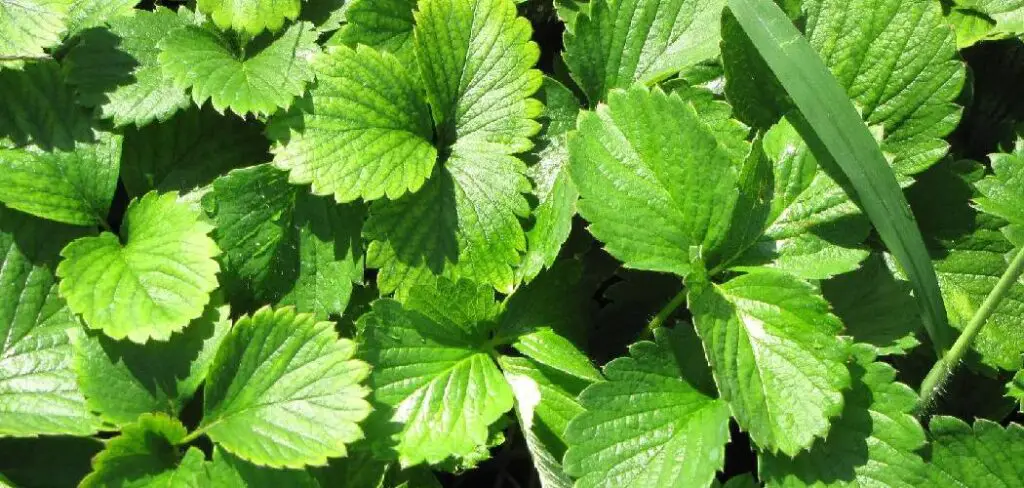
Are you a home gardener who is having trouble getting your strawberry plants to grow to their fullest potential? If so, you may be dealing with nitrogen deficiency – one of the most common nutrient problems experienced by gardeners. Fortunately, there are many effective ways that can help fix nitrogen deficiency in strawberry plants and get them back on the path toward growth and productivity.
In this blog post, we’ll discuss how to identify signs of nitrogen deficiency in strawberry plants as well as various techniques for how to fix nitrogen deficiency in strawberry plants such as fertilization and cover cropping. Read on to learn more about how you can give your strawberry plants the energy they need!
Step-by-step Guidelines on How to Fix Nitrogen Deficiency in Strawberry Plants
Step 1: Identify the Signs

The first step in fixing nitrogen deficiency in strawberry plants is to identify the signs. These may include stunted growth, yellowing leaves, and decreased fruit production. If you notice any of these symptoms, there’s a good chance that your strawberry plants are not getting enough nitrogen. This is because nitrogen is an essential nutrient that plants need for photosynthesis and overall growth.
Step 2: Soil Testing
Once you’ve identified signs of nitrogen deficiency, it’s important to perform a soil test. This will help determine the levels of nitrogen in your soil and inform you on how much fertilizer to apply. You can purchase a soil testing kit from your local gardening store or send a sample to a laboratory for testing. Testing your soil will also give you an idea of its pH level, which is important to consider when choosing a fertilizer.
Step 3: Fertilize Your Soil

Fertilization is one of the most effective ways to fix nitrogen deficiency in strawberry plants. When choosing a fertilizer, look for one that’s high in nitrogen, such as blood meal or fish emulsion. Follow the instructions on the package for application rates and frequency. If you prefer organic options, consider using compost or manure as natural sources of nitrogen.
Step 4: Plant Cover Crops
Another effective method for fixing nitrogen deficiency in strawberry plants is through cover cropping. Cover crops, such as legumes like peas and beans, have the ability to fix nitrogen from the air into their roots and release it back into the soil when they decompose. This can help increase the overall nitrogen levels in your soil and provide a sustainable solution for future plant growth.
Step 5: Mulch Your Plants
Mulching is another simple yet effective way to fix nitrogen deficiency in strawberry plants. By adding a layer of organic mulch, such as straw or grass clippings, around your plants, you can help retain moisture and improve soil health. As the mulch decomposes, it will release small amounts of nitrogen into the soil, providing your plants with a continuous source of nutrients.
Following these steps can help fix nitrogen deficiency in strawberry plants and promote healthy growth. However, it’s important to note that prevention is always better than cure. To avoid future nitrogen deficiencies, make sure to regularly test your soil, rotate your crops, and practice good fertilization techniques. By taking care of your strawberry plants properly, you can ensure a bountiful harvest year after year! Happy gardening!
Additional Tips and Tricks to Fix Nitrogen Deficiency in Strawberry Plants

1. One of the most crucial aspects of fixing nitrogen deficiency in strawberry plants is to make sure that the soil pH level is not too high. High soil pH levels can prevent plants from absorbing enough nitrogen, and so it’s important to maintain a slightly acidic pH level between 5.8 6.2.
2. Another way to supplement nitrogen in your strawberry plants is by adding organic matter to the soil. Composted manure, composted fish emulsion, and other organic materials can help increase nitrogen levels in the soil.
3. In addition to adding organic matter, you can also use nitrogen-rich fertilizers such as blood meal or feather meal to provide a quick boost of nitrogen to your plants.
4. Planting legume cover crops, such as clover or soybeans, in between strawberry plant rows can also help fix nitrogen deficiency. These plants have a symbiotic relationship with nitrogen-fixing bacteria and can increase the overall nitrogen levels in the soil.
5. Mulching around strawberry plants with organic materials, such as straw or grass clippings, can also help retain moisture and prevent nitrogen from leaching out of the soil. This can ensure that your plants have access to enough nitrogen throughout the growing season.
6. Regularly checking and adjusting the nutrient levels in your soil is also important for fixing nitrogen deficiency. Consider conducting a soil test every year to determine if any adjustments need to be made.
7. Finally, make sure to properly water and fertilize your strawberry plants according to their specific needs. Overwatering can lead to nitrogen leaching out of the soil, while under-fertilizing can result in nutrient deficiencies.
By implementing these additional tips and tricks, you can ensure that your strawberry plants have access to enough nitrogen for healthy growth and bountiful harvests. Remember to always monitor your plants and make necessary adjustments as needed to maintain optimal nutrient levels in the soil. So, if you notice any signs of nitrogen deficiency in your strawberry plants, such as stunted growth or yellowing leaves, don’t panic. With the right knowledge and techniques, you can easily fix nitrogen deficiency and help your strawberry plants thrive. Happy gardening!
Things You Should Consider to Fix Nitrogen Deficiency in Strawberry Plants
1. Conduct a soil test to determine the level of nitrogen present in your soil. This will give you an idea of how much nitrogen your strawberry plants are receiving and whether it is enough for healthy growth.
2. Nitrogen deficiency is a common issue in strawberries as they are heavy feeders and require a steady supply of nutrients throughout their growing season. Therefore, consider fertilizing your plants with a nitrogen-rich fertilizer, such as blood meal or fish emulsion.
3. Mulching your strawberry plants can also help with fixing nitrogen deficiency. Organic mulches, such as straw or grass clippings, will break down over time and release nutrients into the soil, including nitrogen.
4. Another way to increase nitrogen levels in the soil is by planting legumes, such as clover or peas, in between rows of strawberry plants. These nitrogen-fixing plants absorb nitrogen from the air and deposit it into the soil, making it available for your strawberries.
5. Rotate your crops to prevent nitrogen depletion in the soil. Planting the same crop in the same location year after year can deplete certain nutrients, including nitrogen. By rotating your crops and planting nitrogen-fixing cover crops in between, you can help maintain a healthy balance of nutrients in the soil.
6. Consider using organic growing practices, such as incorporating compost and green manure into your soil. These methods not only provide a natural source of nitrogen but also improve overall soil health and fertility.
7. Adequate watering is also essential for preventing nitrogen deficiency in strawberry plants. Too much water can leach nitrogen from the soil, while too little water can restrict the plant’s ability to absorb nutrients. Monitor your plants’ moisture levels and adjust watering accordingly.
8. Finally, be patient. It takes time for nitrogen deficiency to show in strawberry plants, and it will also take time for the plants to recover once you have implemented these solutions. Be consistent with your efforts and give your plants the necessary time to rebound.
Following these considerations can help you fix nitrogen deficiency in your strawberry plants and ensure they have the necessary nutrients for healthy growth. Remember to regularly monitor your plants, conduct soil tests, and make adjustments as needed to maintain optimal nutrient levels for a bountiful harvest of delicious strawberries. Happy growing!
Frequently Asked Questions
What is Nitrogen Deficiency in Strawberry Plants?
Nitrogen is an essential nutrient for plant growth and plays a crucial role in the formation of proteins, chlorophyll, and other important compounds. When a strawberry plant does not have enough nitrogen, it can lead to stunted growth and yellowing of leaves, also known as nitrogen deficiency.
How do I know if my Strawberry Plant has Nitrogen Deficiency?
The most common signs of nitrogen deficiency in strawberry plants are yellowing leaves, stunted growth, and small or deformed fruits. The plant may also appear weak and have a lack of vigor.
What Causes Nitrogen Deficiency in Strawberry Plants?
There can be several causes of nitrogen deficiency in strawberry plants, including poor soil quality, excessive rainfall or irrigation, and overuse of nitrogen-rich fertilizers. It can also occur naturally in older plants as they deplete the nutrients in the soil.
Can Nitrogen Deficiency Be Prevented in Strawberry Plants?
Yes, regular soil testing and proper fertilization can help prevent nitrogen deficiency in strawberry plants. It is essential to use a balanced fertilizer that contains nitrogen, phosphorus, and potassium in the correct ratio for optimal plant growth.
Conclusion

Now you know how to fix nitrogen deficiency in strawberry plants. By understanding the signs and causes of nitrogen deficiency, as well as preventative measures, you can ensure your strawberry plants have enough of this essential nutrient for healthy growth and bountiful harvests. Remember to regularly test your soil and use balanced fertilizers to keep your strawberry plants thriving. With proper care, you can enjoy delicious and vibrant strawberries all season long! So, keep these tips in mind and have a fruitful gardening experience!

